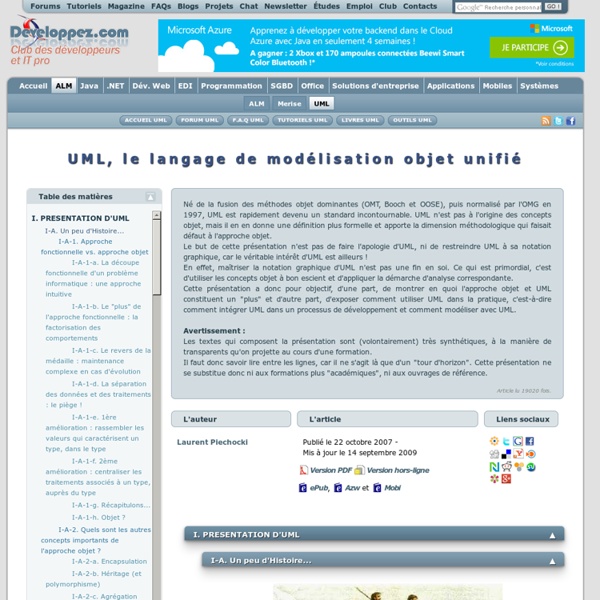Cours UML
Il s'agit de la solution UML pour représenter le modèle conceptuel. Les use cases permettent de structurer les besoins des utilisateurs et les objectifs correspondants d'un système. Ils centrent l'expression des exigences du système sur ses utilisateurs : ils partent du principe que les objectifs du système sont tous motivés. Ils se limitent aux préoccupations "réelles" des utilisateurs ; ils ne présentent pas de solutions d'implémentation et ne forment pas un inventaire fonctionnel du système. Ils identifient les utilisateurs du système (acteurs) et leur interaction avec le système. Il était une fois... Le modèle conceptuel est le type de diagramme UML qui possède la notation la plus simple ; mais paradoxalement c'est aussi celui qui est le plus mal compris ! Au début des années 90, Ivar Jacobson (inventeur de OOSE, une des méthodes fondatrices d'UML) a été nommé chef d'un énorme projet informatique chez Ericsson. Le bénéfice de cette démarche simplificatrice est double.
Index of /Cours/CPI
Index of /Cours/CPI Name Last modified Size Description Parent Directory -
Cours, Exercices, TP, tutoriels en informatique, économie, gestion, français,...
Vous êtes ici : Matières (informatique) > Thèmes (systèmes d'exploitation) > Cours (Qu'est-ce qu'un système d'exploitation ?) Ce chapitre est destiné à mieux comprendre ce qui se cache derrière la notion de système d'exploitation. Il ne présente pas une étude détaillée de tous les systèmes d'exploitation ni même d'un seul en particulier. Il se veut général et accessible à ceux qui ne peuvent pas expliquer même de façon simple ce qu'est un système d'exploitation. Table des matières 1) Pour faire simple 1.1) Définition générale Un concept souvent utilisé et que peu de monde peut expliquer est la notion de système. Etudier le système d'exploitation revient alors à étudier les différents éléments qui le compose, leur rôle et leur objectif pour déterminer l'objectif du système dans sa totalité. Haut de page 1.2) Fonctionnement (très) général et (très) simplifié Sans système d'exploitation, chaque application (logiciel) "communique" directement avec le matériel : 2) Présentation plus détaillée
cours UML Patrice Grand
Related:
Related:



